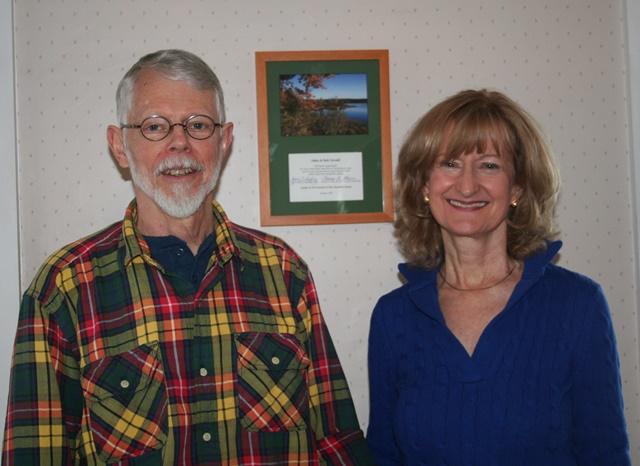Landowners and Donors Save Pawtuckaway Lakefront
- Tags:
- Land Conservation

Rick Fernald stands next to one of the Pawtuckaway property's black gum trees. Photo by Tom Howe.
It takes Sam Demeritt about half a second to pinpoint what galvanized his town of Nottingham to tap into its Conservation Fund to conserve a certain 95-acre forest owned by Rick and Helen Fernald.
“This project was all about keeping Pawtuckaway Lake from being impacted more,” said Demeritt, the chair of the Nottingham Conservation Commission.

Pawtuckaway is Nottingham’s biggest lake. It’s treasured by anglers casting for bass, pickerel and crappies, by waterskiers and kayakers and by swimmers and wildlife watchers, whether they’re locals or visitors enjoying Pawtuckaway State Park, which surrounds nearly half of the lake’s jagged shoreline. The lake’s shores tell a compelling story and seem to offer a choice. Homes line the east and south, while the west and north shores host a couple of public beaches but are still largely undeveloped, thanks mainly to the protection of the state park.
The 95-acre forest sits next to the state park and is also bordered by the lake on one end and Deerfield Road on the other. A stream runs through several forest types there that show abundant signs of moose, deer, otter, porcupine, fishers and many other animals. Near the border with the park, black gum trees have grown large enough to be more than 300 years old. One huge black gum tree just a few feet over the border, in the park, is likely to be a whole lot older than that.
When members of the Conservation Commission got the opportunity to partner with the Forest Society to acquire a conservation easement on the Fernalds’ land, there wasn’t much debate about an opportunity to keep such a special piece of lakefront undeveloped. The town’s selectmen unanimously agreed to support the project, and additional funding came from a grant from the Piscataqua Region Estuaries Partnership, plus many generous individual contributors.
“It’s extending the area covered by the park, and it also has all that frontage on Pawtuckaway Lake. If you put homes in there, you’d ultimately have everything draining into the lake,” Demeritt said.

Fortunately Rick and Helen shared the town’s desire to protect the land and the lake. They made the project possible by selling the conservation easement to the Forest Society for far less than its market value.
Although the Fernalds live in Wolfeboro, Rick grew up in Nottingham, where his family has roots going back to the 1700s and has passed down what he calls “a land-loving gene” from two sides of his family. Rick’s grandfather and great uncles worked together back in the 1930s and ‘40s to collect parcels of land in the Nottingham area to use for cutting timber. His grandmother on the other side of the family also owned land in the area that was passed down through the generations. The easement land is part of a parcel that came from Rick’s grandmother.
The Fernald family has already worked with the town and the Forest Society to protect several of the other family properties now owned by Rick, his brother, Jim Fernald, and sister, Deb Fernald Stevens. In 2006, the siblings sold a conservation easement on 2,027 acres, known as the Mulligan Forest, to the Forest Society, again making the project possible by offering the development rights at a below-market price. That easement, acquired through grants, town funding and individual contributors, enabled the Mulligan Forest to be protected from future development and subdivision but open for public recreation like hiking and hunting. It is still well managed by the Fernald family to furnish lumber and firewood.

The property on Pawtuckaway is similarly managed for timber.
“It’s been a good pine lot,” Rick said.
The desire to conserve it came in part from the success of the Mulligan Forest project, he said, and from witnessing how the area where he grew up has changed and many forests have disappeared in a fast-growing area of New Hampshire.
“This seemed to be the time to do it, and an easement is a good way to protect the land from development but still be able to log it from time to time,” he said.
Every easement is unique, and the Fernalds’ easement on the Pawtuckaway land makes provision for the town, which holds an executory interest in the easement, to put in a small parking area in consultation with the Fernalds to make the land more accessible for low-impact recreation. As the beauty of the land is enjoyed by the community in the future, the land itself will continue to offer a home to wildlife and a buffer of protection to Pawtuckaway Lake.
To view a map of this project, click on the link below.
Fernald_FN_5x35.pdf